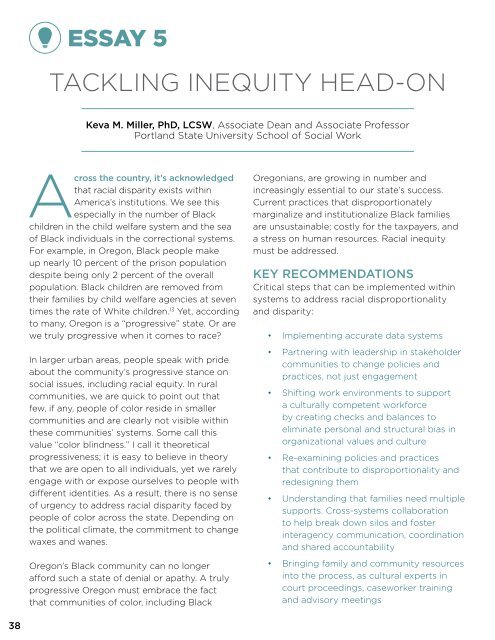State-Of-Black-Oregon-2015
State-Of-Black-Oregon-2015
State-Of-Black-Oregon-2015
You also want an ePaper? Increase the reach of your titles
YUMPU automatically turns print PDFs into web optimized ePapers that Google loves.
ESSAY 5TACKLING INEQUITY HEAD-ONKeva M. Miller, PhD, LCSW, Associate Dean and Associate ProfessorPortland <strong>State</strong> University School of Social WorkAcross the country, it’s acknowledgedthat racial disparity exists withinAmerica’s institutions. We see thisespecially in the number of <strong>Black</strong>children in the child welfare system and the seaof <strong>Black</strong> individuals in the correctional systems.For example, in <strong>Oregon</strong>, <strong>Black</strong> people makeup nearly 10 percent of the prison populationdespite being only 2 percent of the overallpopulation. <strong>Black</strong> children are removed fromtheir families by child welfare agencies at seventimes the rate of White children. 13 Yet, accordingto many, <strong>Oregon</strong> is a “progressive” state. Or arewe truly progressive when it comes to race?In larger urban areas, people speak with prideabout the community’s progressive stance onsocial issues, including racial equity. In ruralcommunities, we are quick to point out thatfew, if any, people of color reside in smallercommunities and are clearly not visible withinthese communities’ systems. Some call thisvalue “color blindness.” I call it theoreticalprogressiveness; it is easy to believe in theorythat we are open to all individuals, yet we rarelyengage with or expose ourselves to people withdifferent identities. As a result, there is no senseof urgency to address racial disparity faced bypeople of color across the state. Depending onthe political climate, the commitment to changewaxes and wanes.<strong>Oregon</strong>’s <strong>Black</strong> community can no longerafford such a state of denial or apathy. A trulyprogressive <strong>Oregon</strong> must embrace the factthat communities of color, including <strong>Black</strong><strong>Oregon</strong>ians, are growing in number andincreasingly essential to our state’s success.Current practices that disproportionatelymarginalize and institutionalize <strong>Black</strong> familiesare unsustainable; costly for the taxpayers, anda stress on human resources. Racial inequitymust be addressed.KEY RECOMMENDATIONSCritical steps that can be implemented withinsystems to address racial disproportionalityand disparity:• Implementing accurate data systems• Partnering with leadership in stakeholdercommunities to change policies andpractices, not just engagement• Shifting work environments to supporta culturally competent workforceby creating checks and balances toeliminate personal and structural bias inorganizational values and culture• Re-examining policies and practicesthat contribute to disproportionality andredesigning them• Understanding that families need multiplesupports. Cross-systems collaborationto help break down silos and fosterinteragency communication, coordinationand shared accountability• Bringing family and community resourcesinto the process, as cultural experts incourt proceedings, caseworker trainingand advisory meetings38


